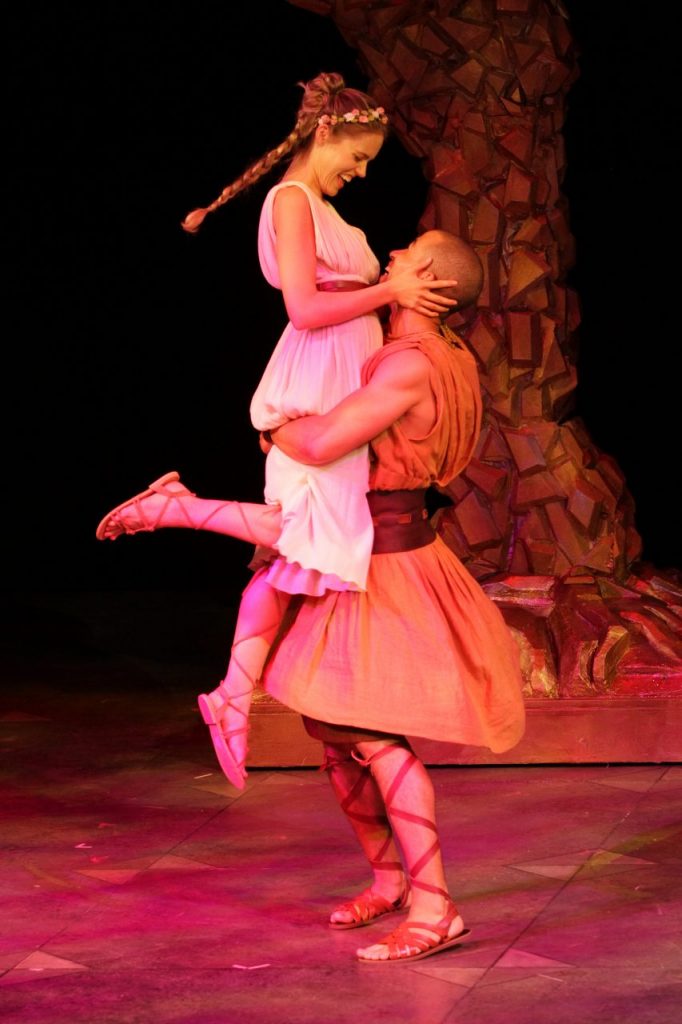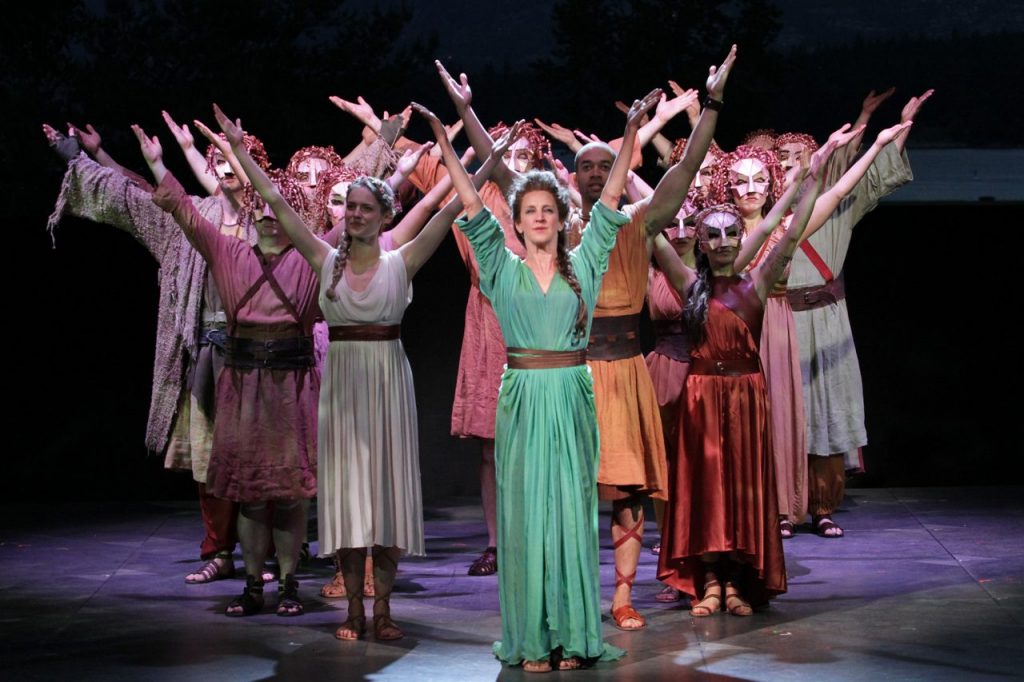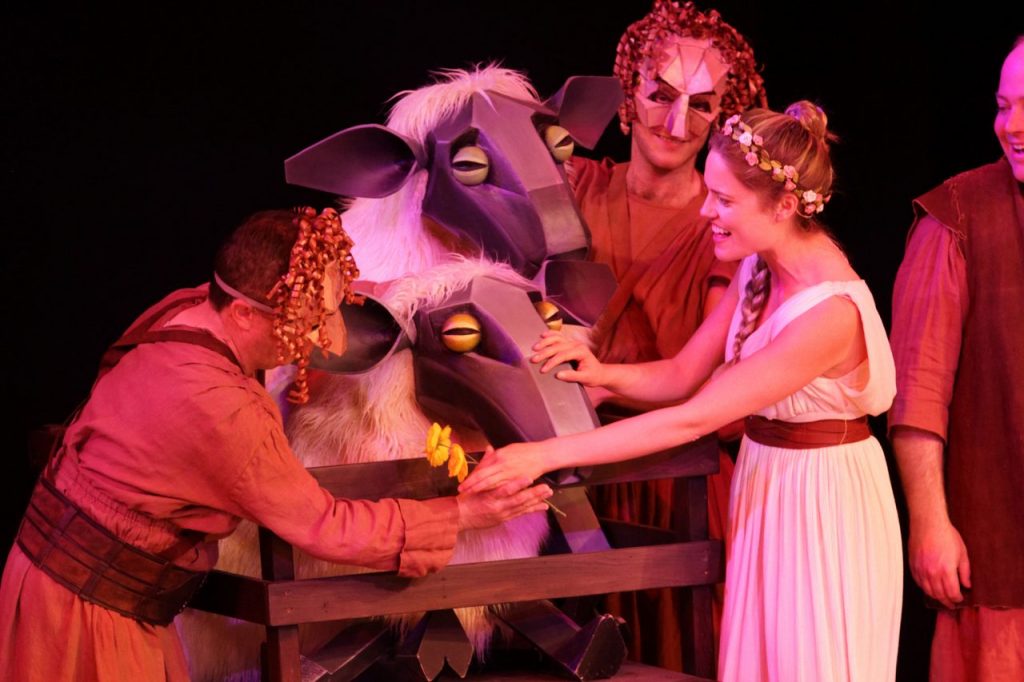
Credit: David Blue
At Bard on the Beach until September 22, 2017
Tickets from $21 at 604-739-0559 or at bardonthebeach.org
Posted June 24, 2017
“A sad tale’s best for winter”. Shakespeare wrote the line for Mamillius, a child, in Act II Scene 1, but director Dean Paul Gibson gives the line to Paulina (Lois Anderson) at the end of the play. Indeed, Paulina figures as large and magical as Prospero in this production and Anderson brings flair and dignity to the role, swirling her voluminous purple robe behind her.
But The Winter’s Tale is, somewhat awkwardly, a sad tale to begin with and a happy tale at the end.
Leontes, King of Sicillia (Kevin MacDonald), without provocation, suddenly suspects his wife Hermione (Sereana Malani) of being “slippery” and “paddling palms” with his friend Polixenes, King of Bohemia (Ian Butcher), who has been visiting Leontes’ court for nine months. Leontes even accuses pregnant Hermione of carrying Polixenes’ child and begins to imagine that his much loved son, Mamillius (Parmiss Sehat), may not be legitimate despite the child’s obvious resemblance to his father.
Mad with jealousy, Leontes orders the murder of Polixenes and the imprisonment of Hermione. Polixenes escape back to Bohemia along with Camillo (Laara Sadiq); Hermione gives birth to a daughter and then she, apparently, dies of a broken heart.
There’s a surprise ending that causes some to weep and some to shake their heads in disbelief.

Credit: David Blue
Strange though the play is, there are fine moments, excellent performances and very high production values not the least of which are Carmen Alatorre’s opulent costumes: brilliant shades of blue, green and turquoise silk. Set designer Pam Johnson renders civilized Sicillia with tall Greco-Roman columns, and pastoral Bohemia with a huge centre-stage tree, flowers and herbs.
Travelling between the two realms, Antigonus (Andrew Wheeler), who has been charged by Leontes to abandon the infant daughter in the woods, is chased by a huge articulated bear while goofy puppet sheep are part of the Bohemia landscape. Credit for the puppet design and construction goes to Heidi Wilkinson and Frances Henry.
MacDonald makes a credible transformation from the young, jealous, clean-shaven Sicillian king in Act I, II and II to the older, repentant, bearded king sixteen years later. Malani’s Hermione is dignified and composed even whilst being falsely accused by Leontes of cuckolding him. Austin Eckert and Kaitlin Williams are the sweet young lovers Florizel and Perdita; Williams, in a pretty, summery frock and with flowers in her hair, appears to float on a cloud of happiness that infuses the whole Bohemia scene.

Credit: David Blue
A highlight in this production is Ben Elliott as Autolycus, a purse-snatching rogue. Elliott seems to be made of elastic bands and his face of play dough; long-legged, he sometimes moves like a giant spider, looping his way across the stage. Autolycus’s every thought is writ large on Elliott’s face.
Wendy Gorling choreographs the rather robotic movement of the masked Sicillian courtiers – signifying, perhaps, the rigidity of the ‘civilized’ world – while Tracey Power choreographs the dances including a spirited dance of the rustics in Bohemia. As in many of Shakespeare’s plays, there is a significant difference between the two spheres – a longing, perhaps, of 17th century London theatregoers to ‘get back to the garden.’ Nothing new under the sun.
‘Tis passing strange, this play. There are lengthy discourses, no swordplay, not a lot of action in the original sense and it shifts over the course of five acts from a tragic beginning to a happy ending. Along the way, however, it’s always interesting and beautiful to behold. But if a winter’s tale is a sad tale, then this play might more aptly have been titled, All’s Well That Ends Well.
Correction: the original review credited Tara Cheyenne Friedenberg with the choreography when in fact Tracey Power choreographed The Winter’s Tale.

Credit: David Blue

